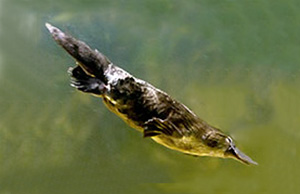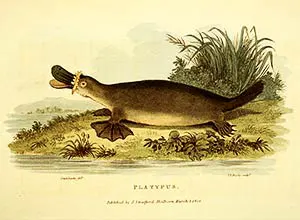
Photo: Platypus swimming
The platypus, an odd aquatic monotreme living in rivers and creeks of Australia, was first named by the English naturalist George Shaw, who called the animal Platypus anatinus. But the name ‘platypus’ was already used, so it was then renamed to Ornithorhynchus anatinus. However the general public preferred the name Platypus, so this is the name that has stuck.
First Names for a Platypus What the Early Settlers Called a Platypus
Early European settlers of Australia called it a duckmole, watermole or duckbill. In 1797 Governor John Hunter of the colony of New South Wales sent some sketches and a pelt of a platypus back to England. When this first specimen arrived in Europe in 1798, it caused much excitement. They had never seen an animal like this before. The scientific community were dumbfounded and sceptical.
A beak like a duck?
A tail like a beaver?
Feet like an otter?
A mammal laying eggs?
They said the animal was a hoax,
a humbug.
They were convinced that it was an elaborate hoax – a fake, stitched together by an expert taxidermist to trick them.
Determination of a Scientific Name How to Resolve Zoological Names

Photo: Early painting of a platypus
In 1799, the English naturalist George Shaw examined and named an odd aquatic Australian animal the Platypus anatinus, which means flat-footed and bird-like. In the meantime, the German anatomist Johann Friedrich Blumenbach, working independently of Shaw, named the animal Ornithorhynchus paradoxus (puzzling bird-billed animal).
However, it was soon discovered that a weevil had already been named 'platypus' so the scientific name was changed to Ornithorhynchus anatinus (bird-like animal).
This is because when a conflict in zoological names is found, a convention is used in determining the new scientific name. To summarise the rule – the oldest name takes precedence.
So they couldn't use the genus name Platypus because it was already assigned to a beetle. The next oldest genus name was given by Blumenbach, which was Ornithorhynchus. So this replaced Platypus. But the sub-genus, Anatinus, assigned by Shaw was older than Paradoxus assigned by Blumenbach. So the sub-genus used became anatinus.
There you have it; the reason for the scientific name of the platypus being Ornithorhynchus anatinus. (See the table for a visual explanation.) But our story doesn't end here. The general public liked the name Platypus. So that's the name that stuck.
It is also known as the duck-billed platypus. Platypus is pronounced pla-tea-pus.
| Named By | Genus | Sub-Genus | Animal | |
|---|---|---|---|---|
| 1793 | Heritt | Platypus | (Many) | Weevil |
| 1799 | Shaw | Platypus | anatinus | Aquatic Monotreme |
| 1800 | Blumenbach | Ornithorhynchus | paradoxus | Aquatic Monotreme |
| Result | Convention | Ornithorhynchus | anatinus | Aquatic Monotreme |
What are Platypus Babies Called? Why are baby platypus called puggles?

Photo: Platypus babies - puggles
There is no word in the English language for a baby platypus. The official name for a baby platypus is just that "baby platypus". Some people call a baby platypus a "puggle". This word has been suggested because it is used for a baby echidna, a member of the same scientific family as the platypus.
The lack of a name for a baby platypus is primarily because it does not emerge from its barrow until it's about three to four months old. By which time, it looks and behaves just like a miniature adult.
All Rights Reserved. (Last Updated: May 21, 2025)